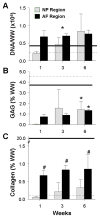Engineered disc-like angle-ply structures for intervertebral disc replacement
- PMID: 20354467
- PMCID: PMC3421837
- DOI: 10.1097/BRS.0b013e3181d74414
Engineered disc-like angle-ply structures for intervertebral disc replacement
Abstract
Study design: To develop a construction algorithm in which electrospun nanofibrous scaffolds are coupled with a biocompatible hydrogel to engineer a mesenchymal stem cell (MSC)-based disc replacement.
Objective: To engineer a disc-like angle-ply structure (DAPS) that replicates the multiscale architecture of the intervertebral disc.
Summary of background data: Successful engineering of a replacement for the intervertebral disc requires replication of its mechanical function and anatomic form. Despite many attempts to engineer a replacement for ailing and degenerated discs, no prior study has replicated the multiscale hierarchical architecture of the native disc, and very few have assessed the mechanical function of formed neo-tissues.
Methods: A new algorithm for the construction of a disc analogue was developed, using agarose to form a central nucleus pulposus (NP) and oriented electrospun nanofibrous scaffolds to form the anulus fibrosus region (AF). Bovine MSCs were seeded into both regions and biochemical, histologic, and mechanical maturation were evaluated with in vitro culture.
Results: We show that mechanical testing in compression and torsion, loading methods commonly used to assess disc mechanics, reveal equilibrium and time-dependent behaviors that are qualitatively similar to native tissue, although lesser in magnitude. Further, we demonstrate that cells seeded into both AF and NP regions adopt distinct morphologies that mirror those seen in native tissue, and that, in the AF region, this ordered community of cells deposit matrix that is organized in an angle-ply configuration. Finally, constructs demonstrate functional development with long-term in vitro culture.
Conclusion: These findings provide a new approach for disc tissue engineering that replicates multi-scale form and function of the intervertebral disc, providing a foundation from which to build a multi-scale, biologic, anatomically and hierarchically relevant composite disc analogue for eventual disc replacement.
Figures






References
-
- Elliott DM, Setton LA. Anisotropic and inhomogeneous tensile behavior of the human anulus fibrosus: experimental measurement and material model predictions. J Biomech Eng. 2001;123:256–263. - PubMed
-
- Johannessen W, Elliott DM. Effects of degeneration on the biphasic material properties of human nucleus pulposus in confined compression. Spine (Phila Pa 1976) 2005;30(24):E724–729. - PubMed
-
- Miller JA, Schmatz C, Schultz AB. Lumbar disc degeneration: correlation with age, sex, and spine level in 600 autopsy specimens. Spine. 1988;13(2):173–178. - PubMed
-
- Acaroglu ER, Iatridis JC, Setton LA, Foster RJ, Mow VC, Weidenbaum M. Degeneration and aging affect the tensile behavior of human lumbar anulus fibrosus. Spine. 1995;20(24):2690–2701. - PubMed
-
- Ebara S, Iatridis JC, Setton LA, Foster RJ, Mow VC, Weidenbaum M. Tensile properties of nondegenerate human lumbar anulus fibrosus. Spine. 1996;21(4):452–461. - PubMed
Publication types
MeSH terms
Substances
Grants and funding
LinkOut - more resources
Full Text Sources
Medical
Research Materials
Miscellaneous

